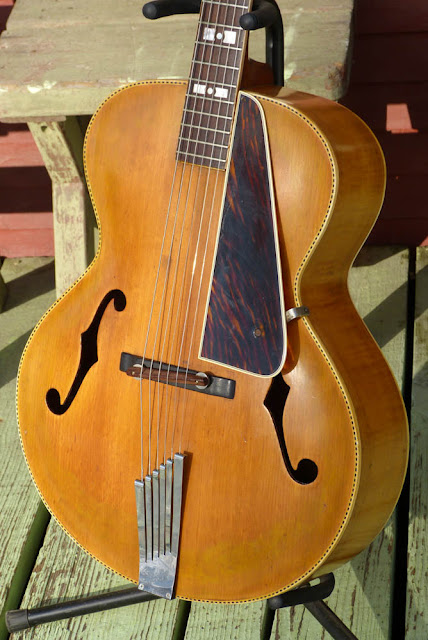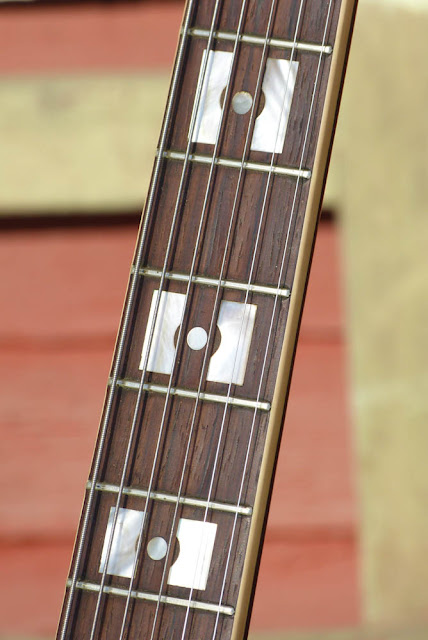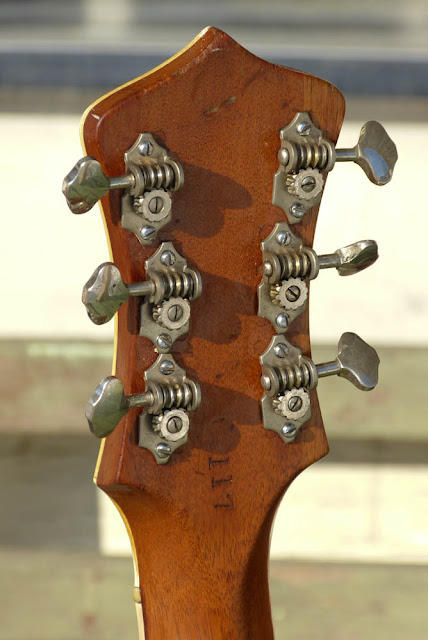c.1940 Gibson-made Francis Day & Hunter Archtop Guitar
Update 2013: I've updated the photos and fleshed-out my description of this guitar. Note also that this has a modern hard case to go with it.
This is a fantastic, Gibson-made carved-top guitar made probably around 1939-1941. It was made for export as noted by the (very hard to photograph) label inside the bass f-hole that reads "Made in USA by Gibson Inc Kalamazoo, Mich." The batch number on the back of the headstock is stamped 117 which suggests a 1940 manufacturing date.
So, what is it? Per the lovely Gibson "Off-Brands" book by Mr. Fox, this can be identified as a Gibson "Francis, Day & Hunter" model made for British export. It was built specifically for that company's distribution catalog and called "style FDH." Unusually for off-brand Gibsons, it was prominently displayed that it was a Gibson product so unlike a Kalamazoo, Cromwell, Kel Kroydon, or similar it was more like a "custom shop" model for a Gibson distributor rather than a budget brand instrument.
And, that said, there's nothing budget about it! It's closest in form and styling to the high-end Recording King M-5 model (also made by Gibson) from around the same time with a carved (rather than pressed) top, tonebar bracing, a deep body (4" sides vs. the usual 3"), full 16" lower bout, a truss-rodded fast and thinner v-shaped neck, and tone that includes a very full bass, sculpted highs, and a heck of a lot of volume and punch. Clearly this was targeted towards a big-band player.
Everything on the guitar is original except for the tailpiece which is a late-40s, early-50s Selmer-sold Compensator type and also perhaps the finish. Catalog descriptions show these to be typically finished in sunburst but knowing the strangeness of Gibson products at the time, it doesn't surprise me that one of these might have been shipped with a blonde finish.
Blonde archtops were sort of all the rage right before WWII so it may have been ordered in this color to begin with. The finish looks like it could be original due to its age and slight "milking" around the top edges, but you can never be sure!
Deluxe appointments abound on the guitar: deco pearl inlays adorn the neck and headstock, the headstock, fretboard, body, and pickguard are all bound, and there's checker purfling on the top edge.
This has a lovely fast neck on it, comparable to high-end Gibsons at the time. I have a '41 Gibson ES-150 that has almost the exact same feel except that it's a rounder shape on the rear.
Original rosewood bridge.
The late-40s Straten Compensator tailpiece is major-cool though it does add a lot more random harmonics into the guitar's tone compared to more typical archtop tailpieces. Its big advantage is the adjusted after-bridge string length which sculpts bass strings to the "bassy" side and treble strings to the "punchy" side of tonality.
The back and sides are flamed maple laminate (I believe) and are buttery-gorgeous.
Nice original Grovers.
The neck joint is spot on.
Tailpiece endpin area.

















Comments
Well I am always on the look out for a FDH archtop here in the UK, as there must be a few hundred lurking under beds & closets yet to come to be discovered.